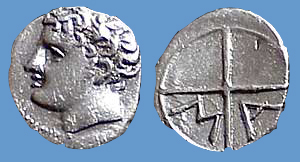Pytheas describes Ireland and the small islands of northern Great Britain: Orkney, Shetlands and Hebrides.
* Ireland
The texts: "Above Great Britain is Ireland, of almost equal area, but oblong in shape between the two equal curves of its shores..." (K36) Pomponius Mela. After Great Britain, it is Ireland that is described by Pytheas. It is smaller, oblong in shape and close to it "to the west" (K34) according to Caesar, but Pomponius Mela and Strabo say to the North. It is a short distance away, as is Britain from Europe (K34). Note that Caesar draws inspiration from books to write about Ireland; he writes it explicitly. And since he has no a priori like Strabo, he simply describes what he reads. We also have a description of the customs of its inhabitants: "anthropophagous, omnivorous, judging it beautiful to eat their dead fathers, and to mingle publicly" (K38). A very graphic description by Strabo. His name is Hierni, which means "the people of the fertile land." Strabo will say about the Irish: "I have nothing very certain to say concerning Ierne, except that the inhabitants are more savage than the Britons since they eat each other and since they consider it an honorable thing when their fathers die to devour them.
 |
Massaliot obole |
* The small islands
Pytheas climbs ever higher towards the north. He designates the islands between Ireland and Britain, then ever further north, "There are thirty Orkneys separated from each other by narrow intervals, and seven Haemodes which advance opposite Germany" (L41). The main islands of the Orkneys are presented, as well as the Shetlands (Haemodes). Pliny also cites the thirty Hebuds which are the Hebrides islands (L42). The latitudes given by Strabo, citing Hipparchus who takes his sources from Pytheas, give us 58° (height of the sun at 4 cubits) in winter. This corresponds to the latitude of the island of Lewis, north of Scotland; then 61° (height of the sun at less than three cubits) which corresponds to the north of the Shetland islands (Q77). A cubit is worth two degrees. This time, it is the height of the sun at noon on the winter solstice that is given by Hipparchus, taking his information from Pytheas.
In winter? Was he there in winter? Hard to believe, because in these regions, he also provides the length, in hours, of summer days. Was he also there in summer? He would have stayed there for at least six months. ?
The scientific hypothesis is the most to be considered. After his journey, he could very well have made simple geometric extrapolations: he would have thus deduced the height of the sun in winter. In winter the sun is at ground level at Thule for a latitude of 66°. At a latitude of 58°, for example, the sun will therefore be at a height of 66°-58°= 8°, or 4 cubits.

